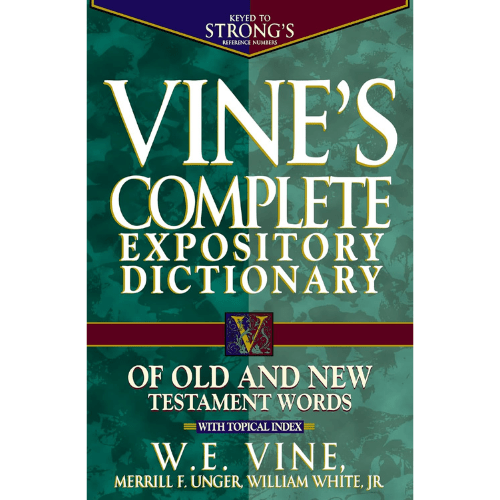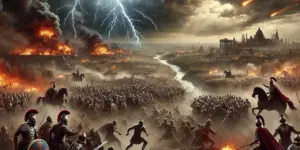Battle of Gog & Magog Introduction
- Battle of Gog & Magog Introduction
- Identifying Gog and Magog
- Biblical Descriptions and Theological Implications
- Historical & Cultural Perspectives of the Battle of Gog & Magog
- Dispensationalist Perspective of the Battle of Gog & Magog
- Partial Preterist Perspective of the Battle of Gog & Magog
- Comparative Analysis of the Battle of Gog & Magog
- Battle of Gog & Magog Conclusion
- Frequently Asked Questions (FAQs) about the Battle of Gog and Magog
- Recommended Bible Study Resources
The Battle of Gog & Magog holds a crucial place in Christian eschatology, symbolizing the final, cataclysmic clash between divine forces and evil adversaries at the end of time. This dramatic prophecy, found in Ezekiel 38-39 and Revelation 20:7-10, has sparked intense interest and debate among theologians, scholars, and believers throughout history. Its portrayal of a great conflict preceding the ultimate triumph of God’s kingdom provides profound insights into the nature of divine justice and redemption.
In this blog post, titled “The Battle of Gog and Magog: Key Insights Revealed,” we will explore the complex identities of Gog and Magog, the concept and significance of the battle itself, and the various interpretative views that have emerged over centuries. By delving into biblical texts, historical contexts, and theological interpretations, we aim to uncover key insights into the battle of Gog & Magog, enhancing our understanding of its role in prophetic scripture and its implications for modern Christian thought. Join us on this journey to unravel one of the most intriguing and enigmatic prophecies in the Bible.
Identifying Gog and Magog
The Battle of Gog & Magog is a deeply significant event in biblical prophecy, prominently mentioned in the books of Ezekiel and Revelation. To understand the full scope of this prophecy, it is essential to identify who Gog and Magog are.
Overview of Gog and Magog in Biblical Scripture
In Ezekiel 38-39, Gog is described as the chief prince of Meshek and Tubal, leading a coalition of nations against Israel in a future battle. Magog is often interpreted as the land from which Gog originates. In Revelation 20:7-10, Gog and Magog reappear as symbols of the nations that will rise against God’s people in the final confrontation after the millennium.
Theories About Their Identity
Symbolic Representations of Evil Forces
One prevalent theory suggests that Gog and Magog are not specific individuals or nations but rather symbolic representations of the ultimate evil forces that oppose God. This view holds that the battle of Gog & Magog symbolizes the perpetual struggle between good and evil, culminating in a final, decisive battle where God triumphs.
Historical Tribes or Nations
Another interpretation is that Gog and Magog represent actual historical tribes or nations. Some scholars have identified Gog with a historical figure, such as Gyges of Lydia, while Magog has been associated with regions inhabited by ancient Scythian tribes. This perspective suggests that Ezekiel’s prophecy was addressing immediate threats to Israel from these neighboring regions, which also have eschatological implications.
Modern Interpretations and Geopolitical Implications
In modern times, the identities of Gog and Magog have been reinterpreted in light of contemporary geopolitical events. Some interpretations link Gog and Magog to modern nations perceived as threats to Israel, often influenced by current political climates. This view posits that the battle of Gog and Magog may signify a future conflict involving these nations, aligning with the prophetic narrative of an end-times war.
Understanding the identities of Gog and Magog is crucial for interpreting the battle of Gog & Magog in biblical prophecy. Whether seen as symbolic representations of evil, historical entities, or modern geopolitical players, these figures play a vital role in eschatological studies. Each interpretation offers unique insights into the nature of this prophesied battle and its implications for both ancient and contemporary contexts.
Vine’s Complete Expository Dictionary
This classic word study resource allows you to study the meaning of biblical words in the original languages without spending years learning Greek or Hebrew.
This classic reference tool has helped thousands dig deeper into the meaning of the biblical text and will enlighten Bible students to the riches of God’s truth in Scripture, opening up God’s word as it has never been opened before.
Biblical Descriptions and Theological Implications
Analysis of Key Passages: Ezekiel 38–39, Revelation 20:7-10
Ezekiel 38–39
In Ezekiel 38–39, the battle of Gog & Magog is described in vivid detail. Gog, from the land of Magog, is depicted as a leader who will gather a vast coalition of nations to attack Israel. This prophecy foretells a time when Israel, dwelling in peace, will be confronted by this formidable enemy. However, God intervenes decisively, bringing about a catastrophic defeat for Gog and his forces through natural disasters and divine judgment. The aftermath includes the purification of the land and the recognition of God’s sovereignty by the nations.
Revelation 20:7-10
In Revelation 20:7-10, the battle of Gog & Magog is revisited in an eschatological context. After the millennium, Satan is released from his prison and deceives the nations, symbolized by Gog and Magog, to gather for a final assault against God’s people. This climactic battle ends with fire descending from heaven to consume the adversaries, and Satan is ultimately cast into the lake of fire, signifying the final defeat of evil.
Role in Prophetic Timelines and Eschatological Narratives
The battle of Gog & Magog occupies a significant place in prophetic timelines and eschatological narratives. In Ezekiel, the battle represents a pivotal moment of divine intervention and judgment against Israel’s enemies, underscoring God’s protection and faithfulness. In Revelation, the battle marks the final confrontation between good and evil, culminating in the ultimate triumph of God’s kingdom.
Theological Significance in God’s Redemptive Plan
Theologically, the battle of Gog & Magog highlights critical aspects of God’s redemptive plan. It demonstrates God’s justice in punishing the wicked and His mercy in delivering His people. The repeated occurrence of this battle in both Old and New Testament prophecies underscores the inevitability of divine victory over evil. It reassures believers of God’s sovereignty and the certainty of His promises, fostering hope and perseverance in the face of adversity.
The battle of Gog & Magog serves as a powerful symbol of God’s ultimate triumph over evil and His unwavering commitment to His redemptive plan. Its depiction in Ezekiel and Revelation provides profound insights into the nature of divine justice, the reality of spiritual warfare, and the assurance of God’s eternal kingdom.
Historical & Cultural Perspectives of the Battle of Gog & Magog
Historical Interpretations
Throughout history, the identities of Gog and Magog have intrigued scholars and theologians. Early Jewish and Christian writings often linked these figures to known historical entities. For instance, Jewish historian Flavius Josephus identified Magog with the Scythians, a nomadic tribe from the north. Early Church Fathers, such as Jerome, also associated Gog and Magog with barbarian tribes threatening the Roman Empire, reflecting contemporary geopolitical anxieties.
Cultural Impact and References in Christian and Jewish Traditions
In Jewish tradition, Gog and Magog are often seen as symbols of ultimate enemies who will be defeated in the messianic age. The Talmud and later rabbinic literature discuss the battle of Gog & Magog as a prelude to the final redemption and the coming of the Messiah. In Christian tradition, especially during the medieval period, Gog and Magog were frequently depicted in art and literature as fearsome invaders from the north, reflecting the ongoing fear of foreign invasions.
The battle of Gog & Magog has also influenced Christian eschatology, particularly in apocalyptic literature. This theme appears in various forms, from medieval manuscripts to modern evangelical writings, often serving as a warning of impending judgment and a call to repentance.
Archaeological and Historical Studies
Archaeological and historical studies have provided some insights that may illuminate the identities of Gog and Magog. Excavations in regions historically linked to the ancient Near East, such as Mesopotamia and Anatolia, have uncovered evidence of various tribes and peoples that might correlate with the biblical descriptions. For instance, inscriptions and records from Assyrian and Babylonian sources mention groups like the Mushki and Tabal (potentially Meshek and Tubal), providing historical context to Ezekiel’s prophecies.
Additionally, some historians suggest that the names Gog and Magog may have been used metaphorically to describe any foreign threats to Israel, rather than specific nations. This perspective aligns with the broader symbolic interpretation of the battle of Gog and Magog, emphasizing its role as a representation of the ultimate struggle between good and evil.
The battle of Gog & Magog has been subject to various interpretations and identifications throughout history, deeply influencing Jewish and Christian traditions. While historical and archaeological studies offer valuable context, the enduring impact of these figures lies in their symbolic representation of the cosmic battle between divine justice and malevolent forces. This multifaceted understanding continues to enrich theological discourse and eschatological expectations.
Dispensationalist Perspective of the Battle of Gog & Magog
Definition and Key Features of the Dispensationalist Viewpoint
Dispensationalism is a theological framework that views history as a series of distinct periods or “dispensations” in which God interacts with humanity in different ways. This perspective emphasizes a literal interpretation of biblical prophecy and a clear distinction between Israel and the Church. Key features include a premillennial understanding of Christ’s return and a future fulfillment of many Old Testament prophecies, particularly concerning Israel.
Interpretation of the Timing and Participants of the Battle
Dispensationalists believe that the battle of Gog & Magog will occur in the future, specifically in the context of end-times events. They typically place this battle either shortly before or during the seven-year Tribulation period, which precedes the Second Coming of Christ. According to this view, Gog represents a coalition of nations led by a powerful leader from the north (often associated with Russia), who will invade Israel.
The participants in this battle are interpreted as modern nations aligned against Israel, reflecting contemporary geopolitical tensions. Dispensationalists often see current events in the Middle East as setting the stage for this prophesied conflict, with nations such as Iran, Turkey, and others potentially involved as allies of Gog.
Implications for Contemporary Christian Thought and Eschatology
The dispensationalist interpretation of the battle of Gog & Magog has significant implications for contemporary Christian thought and eschatology. It reinforces a future-oriented perspective on prophecy, encouraging believers to view current events as fulfilling biblical predictions. This outlook often leads to strong support for Israel, seeing its modern statehood as a fulfillment of God’s promises and a precursor to end-times events.
Furthermore, this perspective fosters a sense of urgency and anticipation among believers, emphasizing the imminence of Christ’s return and the importance of evangelism and spiritual preparedness. By viewing the battle of Gog & Magog as a literal future event, dispensationalists underscore the reality of divine intervention in human history and the ultimate victory of God’s kingdom.
The dispensationalist perspective on the battle of Gog & Magog highlights a literal, future fulfillment of this prophetic event, involving a coalition of nations against Israel. This view shapes contemporary Christian thought by linking current geopolitical developments to biblical prophecy and emphasizing the anticipated return of Christ and the establishment of His eternal kingdom.
Partial Preterist Perspective of the Battle of Gog & Magog
Explanation of the Partial Preterist Approach to Biblical Prophecy
Partial preterism is a theological perspective that interprets many prophecies of the Bible, particularly those in the New Testament, as events that have already occurred, primarily in the first century. This viewpoint holds that significant portions of prophetic scripture, especially those concerning judgment and tribulation, were fulfilled during the destruction of Jerusalem in AD 70. However, partial preterists still anticipate future events, such as the Second Coming of Christ and the final resurrection.
Interpretation of Gog and Magog Events
From a partial preterist perspective, the battle of Gog & Magog is often viewed symbolically or as a representation of past conflicts. This interpretation suggests that the events described in Ezekiel 38–39 and Revelation 20:7-10 symbolize historical or spiritual battles rather than literal, future conflicts. Partial preterists might see the invasion of Gog and Magog as a metaphor for the forces of evil that opposed the early Christian church or as a depiction of the Roman Empire’s oppression of Israel and the nascent Christian community.
In this view, the battle’s primary purpose is to illustrate God’s ultimate victory over evil and the establishment of His kingdom, rather than predicting a specific future event involving modern nations.
Comparison with Dispensational Views
The partial preterist interpretation of the battle of Gog & Magog contrasts sharply with the dispensationalist viewpoint. While dispensationalists view this battle as a literal, future event that will occur in the end times, partial preterists see it as a symbolic or historical event already fulfilled or ongoing in a spiritual sense.
Dispensationalists emphasize a literal fulfillment of prophecies and often link them to contemporary geopolitical events. In contrast, partial preterists focus on the symbolic and theological implications of prophecies, interpreting them within the historical context of the early church and the first-century world.
The partial preterist perspective on the battle of Gog & Magog interprets these events as symbolic representations of past or spiritual conflicts rather than literal, future battles. This approach contrasts with the dispensationalist view, which sees the prophecy as a yet-to-be-fulfilled, future event involving specific nations. By emphasizing the symbolic nature of these prophecies, partial preterists highlight the theological message of God’s victory over evil and the establishment of His eternal kingdom.
Comparative Analysis of the Battle of Gog & Magog
Dispensationalist vs. Partial Preterist Interpretations
Dispensationalist Interpretation
- Timing and Nature: Dispensationalists view the battle of Gog and Magog as a literal, future event that will occur in the end times, either shortly before or during the Tribulation period.
- Participants: This perspective identifies Gog as a leader from the north (often associated with Russia) and Magog as a coalition of nations opposing Israel, reflecting contemporary geopolitical realities.
- Fulfillment: Prophecies are seen as unfolding in a specific, chronological order, emphasizing a literal fulfillment.
Partial Preterist Interpretation
- Timing and Nature: Partial preterists interpret the battle of Gog and Magog symbolically or as a representation of past events, primarily seen as spiritual or historical conflicts rather than future wars.
- Participants: This view does not focus on specific modern nations but rather sees the prophecy as illustrating the cosmic struggle between good and evil, often connected to the first-century context.
- Fulfillment: Prophecies are considered fulfilled or being fulfilled in a symbolic sense, emphasizing the theological message over literal, future events.
Strengths and Weaknesses
Dispensationalist Perspective
Strengths:
- Provides a clear, structured timeline of end-time events.
- Encourages vigilance and a sense of urgency in spiritual readiness.
- Offers a tangible connection between current geopolitical events and biblical prophecy.
Weaknesses:
- May lead to speculative interpretations based on contemporary politics.
- Can be seen as overly literal, potentially missing symbolic meanings.
- May create fear or anxiety about future events.
Partial Preterist Perspective
Strengths:
- Emphasizes the symbolic and theological significance of prophecies.
- Reduces the need for speculative interpretation tied to modern politics.
- Encourages seeing God’s victory as already achieved in a spiritual sense.
Weaknesses:
- Might be perceived as downplaying the relevance of future prophetic fulfillment.
- Less clear on how to interpret ongoing and future events in light of prophecy.
- Can be challenging for those seeking a structured, chronological understanding of eschatology.
Impact on Understanding Biblical Prophecy and Modern-Day Application
Dispensationalist View
- Understanding: This view fosters a sense of anticipation and preparedness for the imminent return of Christ. It encourages believers to interpret current events through a prophetic lens, reinforcing the belief in a literal fulfillment of biblical prophecies.
- Application: Promotes active support for Israel and engages believers in evangelism and spiritual readiness, aligning their lives with the expected timeline of end-time events.
Partial Preterist View
- Understanding: This perspective offers a more immediate relevance of prophecies, suggesting that many have already been fulfilled, thus affirming God’s ongoing redemptive work in history.
- Application: Encourages believers to focus on the symbolic and theological implications of prophecy, fostering a sense of spiritual victory and continuity in God’s plan. It promotes an understanding of eschatology that emphasizes current spiritual growth and the realization of God’s kingdom in everyday life.
The battle of Gog & Magog serves as a significant point of divergence between dispensationalist and partial preterist interpretations. While dispensationalists anticipate a literal, future fulfillment involving specific nations, partial preterists see the prophecy as symbolically or historically fulfilled. Each perspective offers unique strengths and weaknesses, shaping believers’ understanding of biblical prophecy and influencing their application of these teachings in contemporary Christian life.
Battle of Gog & Magog Conclusion
In exploring the battle of Gog & Magog, we have delved into various interpretations and their implications for Christian eschatology. We examined the identities of Gog and Magog through biblical texts, historical perspectives, and modern interpretations, highlighting the diverse ways in which this prophecy has been understood. Dispensationalists view this battle as a literal future event with geopolitical implications, while partial preterists interpret it symbolically, emphasizing past or spiritual conflicts.
The dispensationalist perspective underscores the immediacy and literal nature of end-time events, fostering a sense of vigilance and preparedness among believers. In contrast, the partial preterist view highlights the ongoing fulfillment of prophecy and God’s victory over evil, encouraging a focus on spiritual growth and the realization of God’s kingdom in the present.
Reflecting on the battle of Gog & Magog, we see its profound relevance in contemporary Christian life and theology. This prophecy challenges believers to consider how they interpret biblical texts and how these interpretations shape their understanding of God’s plan. It calls for a balanced approach, appreciating both the symbolic and literal aspects of prophecy, and encourages a deeper engagement with Scripture.
We invite readers to explore these views further in their own study, to seek a comprehensive understanding of the battle of Gog & Magog, and to reflect on its significance for their faith journey. By examining different perspectives, believers can enrich their theological insights and strengthen their spiritual foundation in anticipation of God’s ultimate victory.
Frequently Asked Questions (FAQs) about the Battle of Gog and Magog
1. What is the Battle of Gog and Magog? The Battle of Gog and Magog is a significant prophetic event mentioned in the Bible, specifically in Ezekiel 38-39 and Revelation 20:7-10. It describes a major conflict involving Gog, a leader from the land of Magog, and a coalition of nations against Israel. This battle symbolizes the ultimate struggle between good and evil and is seen as a precursor to God’s final victory over His adversaries.
2. Who are Gog and Magog according to the Bible? Gog is depicted as a chief prince from the land of Magog, leading a coalition of nations against Israel. The exact identities of Gog and Magog have been interpreted variously: some see them as historical tribes or nations, others as symbolic representations of evil forces, and some modern interpretations link them to contemporary geopolitical entities. The exact identification remains a subject of theological debate.
3. How do Dispensationalists interpret the Battle of Gog and Magog?Dispensationalists view the Battle of Gog and Magog as a literal future event that will occur in the end times, either shortly before or during the Tribulation period. They interpret Gog and Magog as leaders of modern nations that will align against Israel, reflecting contemporary geopolitical realities. This perspective emphasizes a chronological fulfillment of biblical prophecy and a clear distinction between Israel and the Church.
4. What is the Partial Preterist view of the Battle of Gog and Magog? Partial Preterists interpret the Battle of Gog and Magog symbolically or as a representation of past events, primarily focusing on spiritual or historical conflicts rather than future wars. They see the prophecy as illustrating the cosmic struggle between good and evil, often related to the first-century context of the early church. This view emphasizes the symbolic and theological significance of the prophecy rather than a literal, future fulfillment.
5. Why is the Battle of Gog and Magog relevant to contemporary Christian life? The Battle of Gog and Magog holds relevance for contemporary Christian life as it underscores the ongoing spiritual battle between good and evil and God’s ultimate victory. It challenges believers to reflect on their interpretation of biblical prophecy and its application in their lives. Whether viewed literally or symbolically, this prophecy encourages vigilance, spiritual preparedness, and a deeper understanding of God’s redemptive plan, reinforcing faith and hope in God’s sovereignty and justice.
Recommended Bible Study Resources
ESV Study Bible – Study Bibles give you a deeper understanding of God’s Word with tools for life application like commentary, maps, charts, concordance, and study notes. Search our popular translations- NIV, ESV, NKJV, KJV and more!
Believer’s Bible Commentary: Second Edition – A Bible commentary is a written, systematic series of explanations and interpretations of Scripture. Commentaries often analyze or expound on individual books of the Bible, chapter by chapter and verse by verse. Some commentary works provide analysis of the whole of Scripture.
The New Strong’s Expanded Exhaustive Concordance of the Bible – The best concordance for word study! This exclusive new edition of a legendary classic puts generations of biblical research at your fingertips. A valuable tool for pastors, teachers, and students of the Bible.
Vine’s Complete Expository Dictionary of Old and New Testament Words – This classic word study resource allows you to study the meaning of biblical words in the original languages without spending years learning Greek or Hebrew. A great resource for students, seasoned pastors, and anyone who enjoys biblical word studies–even if they have little to no formal training in Hebrew or Greek.
Halley’s Bible Handbook – The beloved and classic Bible companion has been thoroughly updated, while retaining its time-honored features and Dr. Halley’s highly personal style, to offer even greater clarity, insight, and usefulness.







